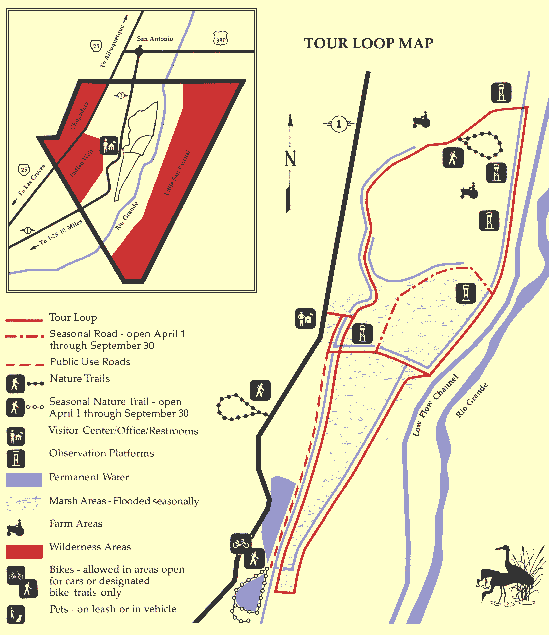
Bosque del Apache has been inhabited for centuries. Over 700 years ago Piro Indians came to the valley for its fertile soil with abundant plant and animal life. These pueblo dwellers farmed, raised turkeys, gathered wild fruit, and hunted wildlife. European diseases and Apache raids forced the Piro to abandon their pueblos inthe 1600's. During the pueblo revolt of 1680 the few remaining Piro fled to El Paso with the Spanish. The Piro never returned to their native land, and their villages fell into ruin.
Late in the 16th century, Spanish explorers and colonists on their way north from Mexico established "El Camino Real," or "Royal Road." This road served as a vital trade avenue between Mexico and Santa Fe for almost 300 years. vestiges of the Camino Real and the Piro occupation are oritected within the Bosque del Apache National Wildlife Refuge.
The 57,191 acre Bosque del Apache National Wildlife Refuge was established in 1939 "as a refuge and breeding grounds for migratory birds and other wildlife." The refuge also provided winter habitat for greater sandhill cranes. In 1941, only 17 cranes used the refuge. Sandhills now number as high as 17,000 on the refuge.
Providing food, water, shelter, and space for wildlife is accomplished by combining management techniques.
The U.S. Fish and Wildlife Service cooperates with local farmers to grow crops for wintering waterfowl and cranes. Farmers plant alfalfa and corn, harvesting the alfalfa and leaving the corn for wildlife. The refuge staff grows corn, winter wheat, clover, and native plants as additional food.
Many cottonwood abd willow bosques that once lined the Rio Grande have been lost to human developments. Salt cedar or "tamarisk," originally introduced as an ornamental and for erosion control, has taken over vast areas and has low wildlife value. Salt cedar is being cleared and areas planted with cottonwood, black willow and understory plants to restore native bosques that have higher value for wildlife.
Irrigation canals insure critical water flow. Daily monitoring, mowing and clearing keeps them functioning. Managing the water enables refuge staff to manage the habitat.
Wildlife viewing is best in the morning and early evening. Here are some tips to make your visit more enjoyable:
For your orientation to the refuge, we suggest stopping at the
Visitor Center. Here you will find current information and sightings,
displays, videos and a bookstore. Hours are Monday through Friday
7:30 AM to 4:00 PM and weekends from 8:00 AM to 4:30 PM year round.
(Note: this no longer appears to be true. The Visitor Center was
not open on the weekend this summer [1994])
The 15 mile auto tour loop allows visitors to enjoy wildlife viewing and photography. Wildlife here is accustomed to visitors and may be closely observed from vehicles, which serve as photo blinds. The refuge tour route is open from one hour before sunrise to one hour after sunset every day of the year.
The Seasonal Tour Road is open April through September. This is an excellent place to observe shorebirds and waders. During the winter, this area is reserved as a roost area for eagles and cranes.
Refuge trails are easy hikes with benches and observation points along the way. (See map for locations.)
Primitive camping is available on a reservation basis to educational and volunteer groups only.
Activities not mentioned are prohibited
The U.S. Fish and Wildlife Service seeks to afford persons with disabilities full accessibility or reasonable accomodation. Contact Refuge Headquarters for information or to address accessibility problems. For the hearing impaired, use you State Relay System for the Deaf.